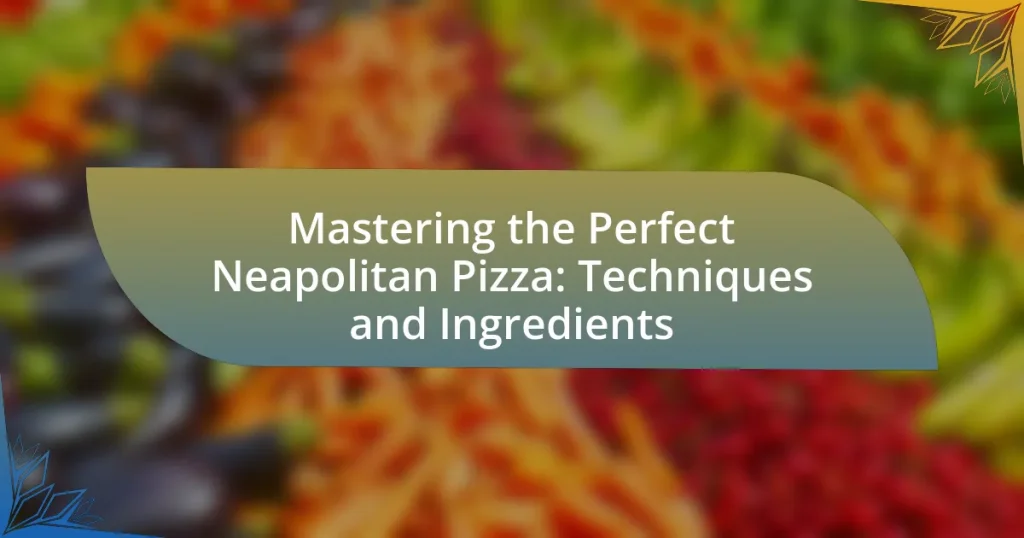Mastering the Perfect Neapolitan Pizza focuses on the essential techniques and ingredients required to create authentic Neapolitan pizza. Key aspects include the use of high-protein flour, San Marzano tomatoes, fresh mozzarella di bufala, and traditional wood-fired cooking methods. The article outlines the unique characteristics of Neapolitan pizza, such as its thin, chewy crust and minimal toppings, while emphasizing the importance of fermentation and proper baking techniques. Additionally, it addresses common mistakes to avoid and provides expert tips for achieving the ideal crust and flavor profile, ensuring a genuine pizza-making experience.

What Makes Neapolitan Pizza Unique?
Neapolitan pizza is unique due to its specific ingredients, traditional preparation methods, and strict adherence to guidelines set by the Associazione Verace Pizza Napoletana (AVPN). The dough is made from high-protein wheat flour, water, salt, and yeast, resulting in a soft, elastic texture. The pizza is typically topped with San Marzano tomatoes, fresh mozzarella di bufala, fresh basil, and extra virgin olive oil, which contribute to its distinctive flavor profile. Additionally, Neapolitan pizza is cooked in a wood-fired oven at high temperatures (around 900°F or 480°C) for a short duration (60-90 seconds), creating a characteristic charred crust that is both chewy and crispy. These elements collectively define Neapolitan pizza and distinguish it from other pizza styles.
How is Neapolitan Pizza different from other pizza styles?
Neapolitan pizza is distinct from other pizza styles primarily due to its specific ingredients, preparation methods, and cooking techniques. This style uses a soft, thin crust made from high-protein flour, San Marzano tomatoes, fresh mozzarella di bufala, and fresh basil, adhering to strict guidelines set by the Associazione Verace Pizza Napoletana. The pizza is traditionally cooked in a wood-fired oven at temperatures exceeding 800°F for about 60-90 seconds, resulting in a characteristic charred yet soft crust. In contrast, other pizza styles, such as New York or Chicago, often feature thicker crusts, different cheese types, and varied toppings, leading to a fundamentally different texture and flavor profile.
What are the key characteristics of Neapolitan Pizza?
Neapolitan Pizza is characterized by its thin, soft crust, which is typically made from high-protein flour, water, salt, and yeast. The dough is hand-kneaded and allowed to rise for a minimum of 24 hours, resulting in a light and airy texture. Authentic Neapolitan Pizza is cooked in a wood-fired oven at temperatures exceeding 800°F (427°C) for about 60-90 seconds, creating a charred, yet chewy crust. The toppings are minimal and traditionally include San Marzano tomatoes, fresh mozzarella di bufala, fresh basil, and a drizzle of extra virgin olive oil. These ingredients are sourced from specific regions in Italy, adhering to the standards set by the Associazione Verace Pizza Napoletana, which ensures authenticity and quality.
Why is the origin of Neapolitan Pizza significant?
The origin of Neapolitan Pizza is significant because it represents a traditional culinary heritage that has been recognized by UNESCO as an Intangible Cultural Heritage of Humanity. This designation highlights the importance of the specific techniques, ingredients, and cultural practices involved in its preparation, which have been passed down through generations in Naples, Italy. The use of high-quality ingredients such as San Marzano tomatoes and mozzarella di bufala, along with the unique cooking method in a wood-fired oven, contributes to its distinct flavor and texture, making it a benchmark for pizza worldwide.
What are the essential ingredients for Neapolitan Pizza?
The essential ingredients for Neapolitan Pizza are flour, water, salt, yeast, San Marzano tomatoes, fresh mozzarella cheese, and fresh basil. These ingredients are crucial for achieving the authentic flavor and texture characteristic of Neapolitan pizza. The flour used is typically a high-protein type, such as “00” flour, which contributes to the dough’s elasticity. San Marzano tomatoes are recognized for their sweetness and low acidity, making them ideal for the sauce. Fresh mozzarella, preferably made from buffalo milk, provides a creamy texture and rich flavor, while fresh basil adds aromatic freshness.
What types of flour are best for Neapolitan Pizza dough?
The best types of flour for Neapolitan pizza dough are Tipo 00 flour and high-protein bread flour. Tipo 00 flour is finely milled and has a high gluten content, which contributes to the dough’s elasticity and allows for a light, airy crust. This flour is traditionally used in Italy for pizza making, as it provides the ideal texture and flavor. High-protein bread flour can also be used as an alternative, as it offers sufficient gluten strength to achieve a similar result. The use of these specific flours is essential for creating the authentic Neapolitan pizza experience, characterized by its soft, chewy crust and well-developed flavor.
How does the quality of tomatoes affect the sauce?
The quality of tomatoes directly influences the flavor, texture, and overall success of the sauce. High-quality tomatoes, such as San Marzano varieties, contain a higher sugar content and lower acidity, resulting in a sweeter, richer sauce that enhances the pizza’s taste. In contrast, inferior tomatoes may lead to a bland or overly acidic sauce, negatively impacting the final dish. Studies have shown that the chemical composition of tomatoes, including their levels of lycopene and other flavor compounds, significantly affects the sensory attributes of sauces, confirming that superior tomatoes yield a more desirable product.
What role does mozzarella play in Neapolitan Pizza?
Mozzarella is a crucial ingredient in Neapolitan pizza, serving as the primary cheese that contributes to its distinctive flavor and texture. This cheese, traditionally made from water buffalo milk, melts beautifully, creating a creamy and rich topping that complements the pizza’s tomato sauce and dough. The use of high-quality mozzarella, such as Mozzarella di Bufala, is essential, as it enhances the overall taste profile and authenticity of the pizza, aligning with the traditional Neapolitan pizza-making standards established by the Associazione Verace Pizza Napoletana.
What techniques are crucial for mastering Neapolitan Pizza?
Crucial techniques for mastering Neapolitan pizza include using high-quality ingredients, proper dough preparation, and mastering the baking process. High-quality ingredients, such as Caputo flour and San Marzano tomatoes, are essential for authentic flavor and texture. Proper dough preparation involves a long fermentation process, typically 24 hours, which develops flavor and elasticity. Mastering the baking process requires a wood-fired oven that reaches temperatures of around 900°F (482°C), allowing the pizza to cook quickly and achieve the characteristic char and leoparding on the crust. These techniques are validated by the Associazione Verace Pizza Napoletana, which sets strict guidelines for authentic Neapolitan pizza preparation.
How do you properly knead and shape the dough?
To properly knead and shape the dough, begin by mixing the ingredients until they form a cohesive mass, then transfer the dough to a floured surface. Knead the dough by pushing it away with the heel of your hand, folding it back over itself, and repeating this process for about 10 minutes until it becomes smooth and elastic. This technique develops gluten, which is essential for the dough’s structure. After kneading, shape the dough into a ball by tucking the edges underneath to create tension on the surface. Allow the dough to rest and rise in a warm environment for at least one hour, which enhances its flavor and texture. This method is supported by the fact that proper kneading and resting times significantly improve the dough’s elasticity and overall quality, as evidenced by traditional pizza-making practices in Naples, where dough is often allowed to ferment for extended periods to develop complex flavors.
What is the importance of fermentation in the dough-making process?
Fermentation is crucial in the dough-making process as it enhances flavor, texture, and leavening. During fermentation, yeast converts sugars into carbon dioxide and alcohol, causing the dough to rise and develop a light, airy structure. This process also produces organic acids that contribute to the dough’s flavor complexity, making it more aromatic and enjoyable. Studies show that longer fermentation times can improve the digestibility of the dough and increase the nutritional value by breaking down gluten and phytic acid, which can inhibit mineral absorption. Therefore, fermentation not only affects the physical properties of the dough but also its taste and health benefits.
How should Neapolitan Pizza be baked for the best results?
Neapolitan pizza should be baked in a wood-fired oven at a temperature of around 800 to 900 degrees Fahrenheit for the best results. This high temperature allows the pizza to cook quickly, typically in 60 to 90 seconds, resulting in a soft, chewy crust with a slightly charred exterior. The intense heat also helps to achieve the characteristic leopard spotting on the crust, which is a hallmark of authentic Neapolitan pizza. According to the Associazione Verace Pizza Napoletana, these specific baking conditions are essential to maintain the traditional qualities of Neapolitan pizza.

What Tools and Equipment Do You Need?
To master the perfect Neapolitan pizza, essential tools and equipment include a pizza stone, a pizza peel, a rolling pin, and a high-temperature oven. The pizza stone retains heat and helps achieve a crispy crust, while the pizza peel allows for easy transfer of the pizza in and out of the oven. A rolling pin is useful for shaping the dough evenly. High-temperature ovens, ideally reaching 800°F to 900°F, are crucial for replicating the traditional wood-fired cooking method that characterizes authentic Neapolitan pizza.
What type of oven is ideal for baking Neapolitan Pizza?
The ideal oven for baking Neapolitan pizza is a wood-fired oven. Wood-fired ovens can reach temperatures of around 800 to 900 degrees Fahrenheit, which is essential for achieving the characteristic char and texture of Neapolitan pizza. This high heat allows the pizza to cook quickly, typically in about 60 to 90 seconds, resulting in a soft, chewy crust with a slightly crispy exterior. The traditional Neapolitan pizza-making guidelines, established by the Associazione Verace Pizza Napoletana, emphasize the use of wood-fired ovens as a key factor in authentic preparation.
How does a wood-fired oven enhance the pizza-making process?
A wood-fired oven enhances the pizza-making process by providing high, consistent temperatures that are essential for achieving the perfect crust and flavor. The intense heat, often exceeding 800°F, allows for rapid cooking, which creates a crispy exterior while maintaining a soft, chewy interior. This cooking method also imparts a unique smoky flavor to the pizza, which is characteristic of traditional Neapolitan pizza. Additionally, the wood used in the oven contributes to the Maillard reaction, enhancing the browning and overall taste of the crust. Historical practices in Italy have shown that wood-fired ovens are integral to authentic pizza-making, as they produce results that cannot be replicated with conventional ovens.
What other tools are essential for preparing Neapolitan Pizza?
Essential tools for preparing Neapolitan pizza include a pizza stone, a pizza peel, and a dough mixer. A pizza stone is crucial as it retains heat and mimics the conditions of a traditional wood-fired oven, allowing for a crispy crust. A pizza peel is necessary for transferring the pizza in and out of the oven, ensuring it maintains its shape and toppings. A dough mixer aids in achieving the right texture and consistency of the dough, which is vital for authentic Neapolitan pizza. These tools collectively enhance the pizza-making process, ensuring quality and authenticity in the final product.
How can you create the perfect pizza environment at home?
To create the perfect pizza environment at home, ensure you have a high-temperature oven, ideally a wood-fired or pizza oven that reaches at least 800°F (427°C). This temperature is crucial for achieving the characteristic char and texture of Neapolitan pizza, as it cooks the dough quickly while retaining moisture. Additionally, use a pizza stone or steel to mimic the heat retention of a traditional oven floor, which helps in creating a crispy crust. Proper ventilation is also essential to manage smoke and heat, enhancing the cooking experience. Finally, gather quality ingredients such as Caputo flour, San Marzano tomatoes, and fresh mozzarella to complement the ideal cooking environment, ensuring the final product meets authentic Neapolitan standards.
What are the best practices for setting up your kitchen?
The best practices for setting up your kitchen for making Neapolitan pizza include organizing essential tools, ensuring proper workspace, and maintaining ingredient quality. First, designate a clean, spacious area for preparation, ideally near the oven, to facilitate efficient workflow. Essential tools such as a pizza stone, peel, and high-quality flour should be readily accessible. Additionally, maintaining a temperature-controlled environment is crucial, as Neapolitan pizza requires specific dough fermentation conditions. Using fresh, high-quality ingredients like San Marzano tomatoes and fresh mozzarella enhances flavor and authenticity. These practices align with traditional methods, ensuring a successful pizza-making experience.
How can you replicate a pizzeria atmosphere at home?
To replicate a pizzeria atmosphere at home, create an inviting space with warm lighting, comfortable seating, and rustic decor reminiscent of traditional pizzerias. Incorporating elements such as checkered tablecloths, wooden pizza peels, and wall art featuring Italian landscapes enhances the ambiance. Additionally, playing Italian music or sounds of a bustling pizzeria can further immerse guests in the experience. Research indicates that environmental factors like lighting and music significantly influence dining experiences, making these elements crucial for achieving an authentic feel.

What Common Mistakes Should You Avoid?
Common mistakes to avoid when mastering the perfect Neapolitan pizza include using the wrong flour type, neglecting dough fermentation, and overloading toppings. Using all-purpose flour instead of “00” flour can result in a less authentic texture, as “00” flour has a higher protein content that contributes to the desired chewiness. Insufficient fermentation time can lead to dense dough; traditional Neapolitan pizza requires at least 24 hours of fermentation for optimal flavor and texture. Overloading toppings can prevent the pizza from cooking evenly, leading to a soggy crust, as Neapolitan pizza is characterized by a balance of ingredients that allows for proper cooking in a high-temperature oven.
What are the pitfalls in making Neapolitan Pizza dough?
The main pitfalls in making Neapolitan pizza dough include using the wrong flour type, improper hydration levels, inadequate fermentation time, and incorrect kneading techniques. Using flour with insufficient protein content can lead to a weak dough structure, while too much or too little water can affect the dough’s elasticity and texture. Fermentation is crucial; insufficient time can result in a dense crust, whereas over-fermentation can lead to a sour flavor. Lastly, improper kneading can prevent gluten development, which is essential for achieving the desired chewy texture. These factors are critical for creating authentic Neapolitan pizza dough, as outlined by pizza-making experts and culinary studies.
How can over-kneading affect the texture of the dough?
Over-kneading can lead to a tough and dense texture in the dough. When dough is kneaded excessively, the gluten proteins become overly developed, resulting in a structure that is too tight and lacks the desired elasticity. This excessive gluten formation restricts the dough’s ability to rise properly, leading to a final product that is chewy rather than light and airy, which is essential for a perfect Neapolitan pizza. Studies in baking science indicate that optimal gluten development occurs with moderate kneading, allowing for a balance between strength and extensibility, crucial for achieving the ideal pizza crust.
What happens if you use the wrong type of flour?
Using the wrong type of flour can significantly affect the texture and flavor of Neapolitan pizza. For instance, using all-purpose flour instead of 00 flour, which is specifically designed for pizza, can result in a denser crust that lacks the desired chewiness and elasticity. This is because 00 flour has a higher protein content and finer grind, which contributes to the ideal gluten structure necessary for a light and airy crust. Studies show that the protein content in flour directly influences the dough’s ability to rise and develop the right texture, making the choice of flour critical for achieving authentic Neapolitan pizza.
What are the common baking errors to watch out for?
Common baking errors to watch out for include incorrect oven temperature, inadequate dough fermentation, and improper ingredient measurements. Incorrect oven temperature can lead to uneven baking, resulting in a burnt crust or undercooked center; for Neapolitan pizza, the ideal temperature is around 800°F (427°C). Inadequate dough fermentation affects the texture and flavor, as proper fermentation develops gluten and enhances taste; typically, dough should ferment for at least 24 hours. Improper ingredient measurements can cause imbalances in the dough, leading to poor rise and texture; using a kitchen scale for precise measurements is recommended.
How can improper oven temperature ruin your pizza?
Improper oven temperature can ruin your pizza by preventing it from cooking evenly and achieving the desired texture. When the oven is too hot, the crust may burn before the toppings are fully cooked, leading to a charred exterior and raw interior. Conversely, if the oven temperature is too low, the pizza may become soggy as the dough does not crisp up properly, resulting in an unappetizing, limp texture. The ideal temperature for Neapolitan pizza is typically around 800 to 900 degrees Fahrenheit, which allows for a quick bake that creates a perfect balance of a crispy crust and well-cooked toppings.
What are the signs of undercooked or overcooked pizza?
Undercooked pizza typically shows a doughy texture, a pale crust, and a lack of browning, while overcooked pizza exhibits a burnt crust, overly dry toppings, and a hard texture. The doughy texture in undercooked pizza indicates insufficient cooking time, which prevents the starches from gelatinizing properly. Conversely, the burnt crust in overcooked pizza results from excessive heat exposure, leading to carbonization of the crust. These signs are crucial for achieving the ideal Neapolitan pizza, which should have a well-cooked, slightly charred crust and properly melted toppings.
What Tips Can Help You Perfect Your Neapolitan Pizza?
To perfect your Neapolitan pizza, focus on using high-quality ingredients, particularly Caputo 00 flour, San Marzano tomatoes, and fresh mozzarella. These ingredients are essential because Caputo 00 flour provides the ideal texture and elasticity for the dough, while San Marzano tomatoes offer a rich flavor profile that is characteristic of authentic Neapolitan pizza. Additionally, using fresh mozzarella ensures a creamy texture and authentic taste.
Kneading the dough properly and allowing it to rise for at least 24 hours enhances its flavor and texture. The dough should be hand-stretched rather than rolled to maintain its airiness. Baking at a high temperature, ideally in a wood-fired oven at around 900°F (482°C), creates the signature char and crispiness.
These techniques are validated by the Associazione Verace Pizza Napoletana, which outlines the standards for authentic Neapolitan pizza preparation.
How can you adjust your technique based on ingredient quality?
To adjust your technique based on ingredient quality, you should modify your preparation and cooking methods to enhance the characteristics of the ingredients used. For instance, high-quality flour with a higher protein content requires less water and shorter kneading times to achieve optimal gluten development, while lower-quality flour may need more hydration and longer kneading to compensate for its weaker structure. Additionally, fresh, high-quality tomatoes should be used raw or minimally cooked to preserve their flavor, whereas canned or lower-quality tomatoes may benefit from longer cooking to develop a richer taste. This approach aligns with culinary principles that emphasize the importance of ingredient quality in achieving the desired flavor and texture in dishes, particularly in traditional recipes like Neapolitan pizza.
What are some expert tips for achieving the ideal crust?
To achieve the ideal crust for Neapolitan pizza, use high-protein flour, such as Caputo 00, which provides the necessary gluten structure for a chewy texture. Additionally, ensure proper hydration by using a dough hydration level of around 60-65%, which helps create an airy crust. Ferment the dough for at least 24 hours at a cool temperature to develop flavor and texture. Preheat your oven to a high temperature, ideally around 800°F (427°C), to achieve the characteristic char and crispness. Finally, stretch the dough by hand rather than using a rolling pin to maintain the air bubbles, which contribute to the crust’s lightness. These techniques are supported by traditional Neapolitan pizza-making standards, as outlined by the Associazione Verace Pizza Napoletana.















